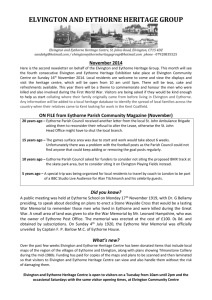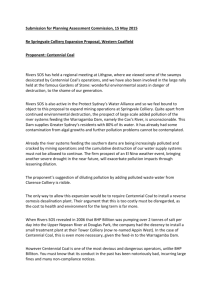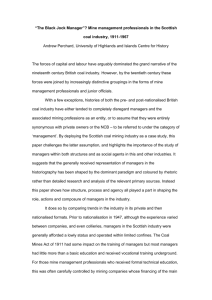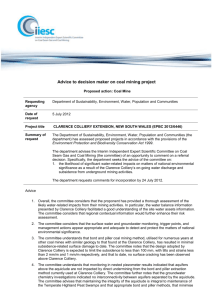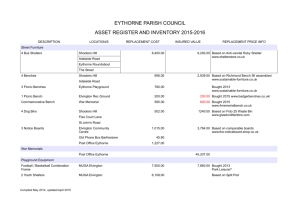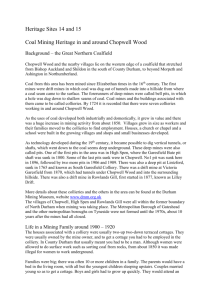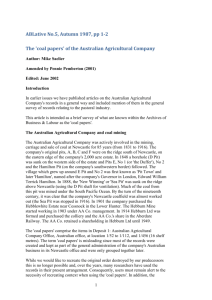Elvington and Eythorne Heritage Centre Elvington and Eythorne
advertisement
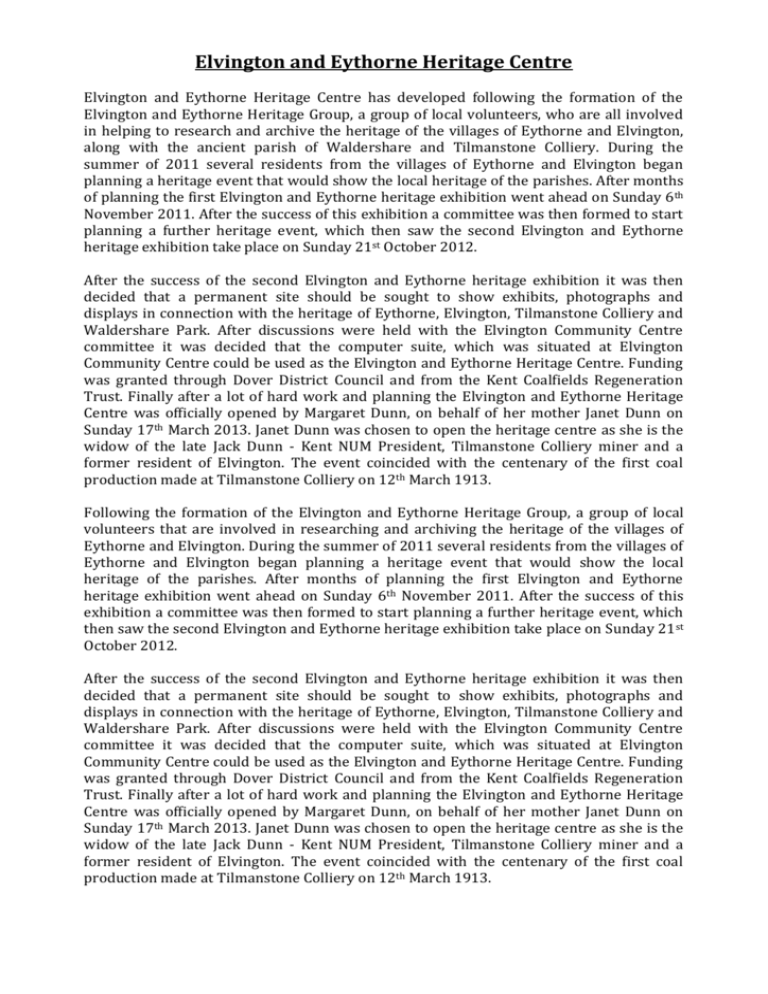
Elvington and Eythorne Heritage Centre Elvington and Eythorne Heritage Centre has developed following the formation of the Elvington and Eythorne Heritage Group, a group of local volunteers, who are all involved in helping to research and archive the heritage of the villages of Eythorne and Elvington, along with the ancient parish of Waldershare and Tilmanstone Colliery. During the summer of 2011 several residents from the villages of Eythorne and Elvington began planning a heritage event that would show the local heritage of the parishes. After months of planning the first Elvington and Eythorne heritage exhibition went ahead on Sunday 6 th November 2011. After the success of this exhibition a committee was then formed to start planning a further heritage event, which then saw the second Elvington and Eythorne heritage exhibition take place on Sunday 21st October 2012. After the success of the second Elvington and Eythorne heritage exhibition it was then decided that a permanent site should be sought to show exhibits, photographs and displays in connection with the heritage of Eythorne, Elvington, Tilmanstone Colliery and Waldershare Park. After discussions were held with the Elvington Community Centre committee it was decided that the computer suite, which was situated at Elvington Community Centre could be used as the Elvington and Eythorne Heritage Centre. Funding was granted through Dover District Council and from the Kent Coalfields Regeneration Trust. Finally after a lot of hard work and planning the Elvington and Eythorne Heritage Centre was officially opened by Margaret Dunn, on behalf of her mother Janet Dunn on Sunday 17th March 2013. Janet Dunn was chosen to open the heritage centre as she is the widow of the late Jack Dunn - Kent NUM President, Tilmanstone Colliery miner and a former resident of Elvington. The event coincided with the centenary of the first coal production made at Tilmanstone Colliery on 12th March 1913. Following the formation of the Elvington and Eythorne Heritage Group, a group of local volunteers that are involved in researching and archiving the heritage of the villages of Eythorne and Elvington. During the summer of 2011 several residents from the villages of Eythorne and Elvington began planning a heritage event that would show the local heritage of the parishes. After months of planning the first Elvington and Eythorne heritage exhibition went ahead on Sunday 6th November 2011. After the success of this exhibition a committee was then formed to start planning a further heritage event, which then saw the second Elvington and Eythorne heritage exhibition take place on Sunday 21st October 2012. After the success of the second Elvington and Eythorne heritage exhibition it was then decided that a permanent site should be sought to show exhibits, photographs and displays in connection with the heritage of Eythorne, Elvington, Tilmanstone Colliery and Waldershare Park. After discussions were held with the Elvington Community Centre committee it was decided that the computer suite, which was situated at Elvington Community Centre could be used as the Elvington and Eythorne Heritage Centre. Funding was granted through Dover District Council and from the Kent Coalfields Regeneration Trust. Finally after a lot of hard work and planning the Elvington and Eythorne Heritage Centre was officially opened by Margaret Dunn, on behalf of her mother Janet Dunn on Sunday 17th March 2013. Janet Dunn was chosen to open the heritage centre as she is the widow of the late Jack Dunn - Kent NUM President, Tilmanstone Colliery miner and a former resident of Elvington. The event coincided with the centenary of the first coal production made at Tilmanstone Colliery on 12th March 1913. Tilmanstone Colliery Geologists had first speculated that there was coal beneath Kent from as early as the 1840s, following the discovery of coal at Oignies, in France. This resulted in the development of the Pas de Calais Coalfield and by 1852 there were collieries established at Lens, Bruay and Courrieres in France and Belgium. In 1880, work began at Shakespeare Cliff on a Channel Tunnel from Dover to Calais, but in 1882, the Government halted the work while it considered the military implications. The company decided to then drill bore holes to investigate Kent’s geology and both iron ore and coal were found in 1890. In 1896, Arthur Burr set up the Kent Coalfields Syndicate buying the mineral rights and commenced Shakespeare Colliery at the tunnel workings. The sinking of the No.1 shaft (The Brady Pit) took place in June 1896, with boreholes. Two further shafts were eventually sunk, but during the early stages of development water was struck at 366 feet and the shaft flooded. Over the next 25 years the Kent Coalfield came close to being abandoned on numerous occasions. From 1896 more than 40 test bores were carried out across Kent and at least 10 collieries were started and it took 16 years of continual investment before any commercial coal was raised to the surface. Part of the problem was that the coal was very deep underground situated in thin undulating seams that were difficult to mine. Water resulted in several serious floods at the collieries and often 250 gallons (1135 litres) a minute could pour into the mine workings. Pumps were often working to their limit leaving miners wading in water. There was the constant danger of flash floods and on occasion the sinkers were killed with 1,000 feet shafts being flooded to surface level within minutes. On 18th April 1906, the Foncage Syndicate was registered by Arthur Burr as a small subsidiary company of Kent Coal Concessions to undertake surface works and a small amount of shaft sinking. The new company immediately started a shaft at Tilmanstone Colliery, original called East Kent Colliery, near the village of Eythorne under an agreement with Kent Coal Concessions Ltd. Good coal seams had also been discovered in borings at Waldershare Park and a colliery was established being called Guilford Colliery, named after the Earl of Guilford who owned the land at Waldershare Park. Sinking started on a shaft in July 1906 with a small shaft, which was intended to reach the coal measures, but when thick seams were reached in October 1906 the Syndicate increased its capital to £20,000 in order to provide an adequate sinking plant and surface equipment for the purpose of sinking two 18 feet diameter shafts. Arthur Burr was convinced that there was more coal beneath Kent, which would make both the and investors rich, but he had obviously not counted on flooding, or the coal being so far down, the seams being thin and folded, or the coal being initially a poor quality. Bore holes were set out across an area of east Kent to test where the best coal seams were. Between 1904 and 1910 Arthur Burr started five more collieries, with each colliery running into the same problems of flooding creating even more expense. None of the collieries managed to raise coal for commercial sale until 1912, with coal finally being brought to the surface at Snowdown Colliery in the November. Progress continued at the East Kent Colliery (Tilmanstone Colliery). The first wages were paid to the workers on 7th July 1906 and work had begun on sinking the first shaft on 19th July 1906. With the discovery of a viable coal seam in a test boring at Waldershare Park, a shaft at Tilmanstone Colliery was widened to 14 feet and sinking progressed on the No.1 Shaft. A second shaft measuring 18 feet in diameter was begun on 19th November 1907. The first sod was turned by a grand daughter of the colliery owner and was called the “Gabrielle Pit”. In May 1908, the first shaft at Tilmanstone Colliery had reached a depth of 913 feet. The sinking of a third shaft was eventually begun in August 1910, which was called the "Rowena Pit", named after another grand daughter of the colliery owner. It would take a further two years for this shaft to reach the coal measures and coal was eventually reached in 1912, with sinking continuing towards the Beresford seam. By December 1912 all three shafts were sinking into the coal measures. Progress continued and struck the 5’ 0” Beresford Seam (No.1 Seam) at a depth of 1,560 feet in March 1913 and the first coal was raised on 12th March 1913. Arthur Burr Between 1905 and 1910 Arthur Burr had created at least five collieries, one of which was the East Kent Colliery (Tilmanstone Colliery), and by 1910 he had formed Kent Coal Concessions, before becoming the Director or Manager of 22 companies. He became selfappointed Director General of the East Kent Contract and Financial Company in 1912, after initially forming the Kent Coal Company in 1896, building a colliery below Shakespeare Cliff. The coal mined at Dover Colliery was never commercially viable and costs had risen to more than £1 million, following predicted costs of £50,000 and an estimated production of 3,000 tons of coal per day in 1900. Arthur Burr convinced investors of the viability of coal being mined in Kent. For almost 20 years Arthur Burr had formed new companies who would act as subcontractors for existing businesses under his control. Each of the different subcontractors would then be responsible for different tasks in the construction and everyday running of each colliery, with one building winding houses and offices, another sinking shafts and then another would actually own the mineral rights. Mr. Burr became a Freeman of Dover and received his Honorary Freedom of Dover on 4th February 1913. He was praised by the Mayor of Dover as ‘as one of the greatest benefactors Dover had ever known’. By May 1914 investors were accusing Burr of being a conman and at a meeting of shareholders agreed to advance £30,000 to settle bills. Burr was eventually forced out of holding all posts and legal steps were later started for fraud and misuse of funds. In March 1919, a meeting of bankruptcy was held at court to examine his financial affairs. Arthur Burr died later that year with several legal actions made against him and had £80,000 worth of judgements against him. Richard Tilden Smith Richard Tilden Smith was born in New South Wales, Australia, 1865. He had become the owner of 5million acres of land with 75,000 head of cattle and also discovered gold deposits on his land, before becoming in charge of the development of the Midland Coalfield, which was the main source of coal in Australian and at the age of 21. Arriving in England he quickly gained a reputation for reconstructing businesses that were in danger of closure. By 1929 it was reported that Tilden Smith had successfully saved companies to the value of £200million. He later became a Director of the Burma mines in 1908 and also held controlling interest in Chinese Mines. Richard Tilden Smith became involved with plans to develop the Kent Coalfield as early as 1907 and had a particular interested in obtaining ownership of Tilmanstone Colliery in 1915. After applying for the colliery to be placed under his management he was made Manager of the colliery in 1925, appointed by the Receiver. After a successful period of Receivership, Tilden Smith then applied for permission to reconstruct the company in July 1925 and then became the colliery owner, with the company becoming Tilmanstone (Kent) Colliery Company Ltd. Once taking over control of Tilmanstone Colliery he quickly wanted to make many changes to the colliery and more importantly he felt the need to take care and have appreciation for his workforce. The majority of housing built in Elvington came from the decisions made by Tilden Smith. However, the untimely death of Tilden Smith on 18th December 1929, who was reported to have collapsed after a meeting with politicians, to promote the coal industry in Kent, led to the end of his vision of an ‘Industrial Eden’ for the Kent Coalfield. Elvington village and mining community With the arrival of miners and their families coming to the Kent Coalfield to find work from as far afield as Scotland, Wales, Yorkshire, the Midlands and Somerset it was decided that each colliery would have special housing estates built to accommodate them. The mining community of Elvington village had its first buildings constructed in 1910/11, which were situated on the westward hillside above Tilmanstone Colliery. By 1916 there were some 32 houses in Elvington and a building that became Tilmanstone Colliery Working Men’s Club. The lease of an empty building was held by Kent Coal Concessions and was rented by the Club, paid for by a weekly deduction from the miners’ wages. In 1931 the name of the building was changed to the Elvington Working Men’s Club. Ladies were not allowed to become members until 1952. Richard Tilden Smith became the owner of Tilmanstone Colliery in 1925. He expressed his concerns to wanting the miners and their families to have good comfort and so arranged for a workmen’s representative, who would look into the suitability of setting up various housing schemes. The first scheme saw 100 houses being built, that were followed by a steady flow of a further 230 houses all built by R. J. Barwick Building Contractors of Dover in the Elvington Town Scheme. Miners and their families were given the choice of renting 2, 3 or 4 bedroom houses. Rent for the houses included water and deliveries of coal given by the colliery to each household forming part of the wage agreement. The home running costs such as rent, rates, lighting, cooking and heating were deducted before each man got his wage. The dimension and facilities that can be found in one of the houses built in Elvington had the ground floor with a 13ft x 11ft living room, 12ft x 11ft parlour, and 11ft x 7ft scullery that contained a cooking range, copper and sink. The first floor had a 12ft x 11ft main bedroom, 11ft x 9ft 2nd bedroom, 11ft x 10ft 6in 3rd bedroom, a 7ft x 5ft 5in Bathroom with hot and cold water supplied and a separate toilet. There was also a yard, larder and coal shed on ground floor. By the 1930s Elvington had Co-operative butcher, greengrocer and general groceries shop. Elvington became a model development, so that every house had a garden, hot water, gas and an inside toilet. The whole area was made more attractive with the planting of trees and shrubs. Elvington was run by a Welfare Committee, with the members being elected through the Union. After privatisation the majority of houses in Elvington were owned by the National Coal Board, who continued to maintain the houses with a site for a work shop in Chaucer Road. The houses were later sold to Eastry Rural District Council. During the 1940s prefabricated houses were built along Sweetbriar Lane and more recently a council estate. On the present site of Elvington Community Centre was the settlement hall that was used for leisure, educational and welfare facilities. In 1959 a new welfare hall was opened, at a cost of £12,000 provided by the Coal Industry and Social Welfare Organisation and the Ministry of Education. The building held activities that included a County Library, Child Welfare Clinics, meetings of the Eythorne and District Darby and Joan Club, the local Women’s Institute, the Welfare Dramatic Group, Badminton groups. In 2000 a newly refurbished hall was opened after a devastating fire almost destroyed the building. Prior to Elvington village being built some of the first miners who came to work at Tilmanstone Colliery were provided with accommodation at the nearby mansion house of Elvington Court, let by Richard Tilden Smith. This fine, large, Tudor style mansion house and was situated in the grounds adjacent to the Tilmanstone Colliery Sports Ground. Richard Tilden Smith allowed Elvington Court to become a hostel for the miners, along with an adjoining barn that had been converted into a leisure centre. The barn was converted by the workmen voluntarily and allowed a seating capacity of 750 people, with the addition of electric lighting, heating, a dance floor and had a proper stage with dressing rooms. There were regular dances held in the huge barn, with boxing tournaments, concerts and a gymnasium. Miners were charged 25 shillings a week board, which paid for their accommodation at Elvington Court. Regular meals were prepared for the miners, along with the workers’ snap (work food). Adjacent to the barn was an ambulance station complete with uniforms and equipment. Tilden Smith’s own Rolls Royce car was converted into an ambulance and became the first St. John Ambulance Brigade unit in the Kent Coalfield. At the rear of the mansion Tilden Smith had a pig farm and supplied a butcher, who provided as much cheap pork to the miners as they wanted. Elvington Court eventually became derelict and was demolished during the 1950s. A sports field was also laid out on the estate and all these amenities were to help create a close-knit community. On Saturday 15th May 1937, a sister of Richard Tilden Smith, who was visiting from Australia, officially opened the playing field that was provided by the Miners Welfare Fund for the men who worked at Tilmanstone Colliery and their families. Sporting activities were encouraged and included athletics, bowling, boxing, cricket, football and tennis teams, with regular matches played against other teams. A Tilmanstone Colliery male voice choir was also formed.
